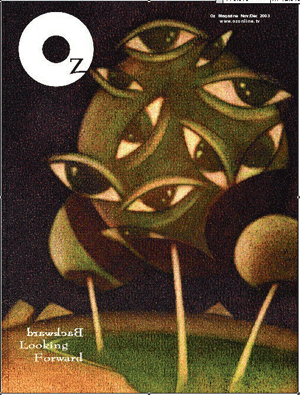|
Backward Looking Forward
THE HISTORY OF ATLANTA ADVERTISING

By Lee Drew
Illustrations by Gregory Krumm
Five years ago
the future of
Atlanta advertising
looked a lot like
Luke Sullivan, the
newly hired
creative head of
the city's
burgeoning powerhouse
agency WestWayne.
He was the
personification of
the city's latest
stab at creative
renaissance.

Sullivan, from Fallon McElligot in Minneapolis, was the latest talent to enter the market with the expectation he would overcome decades of inertia, insecurity and frustration to
definitively establish Atlanta as an emerald city of creative might.
For people who remember far back enough, Kurt Tausche was burdened with similar expectations when he came to Atlanta in the mid-1980s and joined Burton-Campbell/EPB as a last-ditch effort to save that shop from its precipitous decline and, in the process, lift the city by example. It did not work.
Years before that, Richmond, VA agency Cargill Wilson & Acree's opened an Atlanta office that was supposed to
carry the city to glistening creative heights and change its reputation as a place of solid, but not consistently remarkable, advertising. In the five years since Sullivan came to Atlanta in 1998, a lot of things happened, including his departure from WestWayne this year to take a job at GSD&M in Austin. The dream . . .Atlanta, finally installed atop Olympus with Portland and Minneapolis as a great ad town . . .did not come true. A kind of nightmare ensued instead.
The New Economy of dot commerce came and went, and the recession came and stayed. In the middle came the terrorist attacks of Sept. 11, 2001, which cast a pall over the entire nation. The Atlanta agency scene went through tumultuous times as venerated shops like Ogilvy & Mather disappeared, absorbed by J. Walter Thompson, and big hometown clients like Home Depot finally began spending big bucks on advertising ($300 million plus) . . .but went to Texas to hire an advertising agency (The Richards Group).
Upstart agencies, such as Huey/Paprocki, Match, Inc. and a reinvigorated Sawyer Riley Compton, showed creative firepower, collecting awards and generating buzz and excitement about the work. Another shop, Highpoint, NC based Trone, entered the market in 2000 when it purchased Pollak Levitt & Partners. A year later the shop won the Mirant and Children's Healthcare of Atlanta accounts. That same year, WestWayne lost the Celebrity Cruise Line and Saks Department Store Group accounts and trimmed staff.
But, for the last two years the earth mostly went flat in new business in the city as it did nationwide. The fallout from vanished dot.coms, and the downsizing of recession-pinched clients shrank budgets and forced agencies to trim staffs. The business continues to shed jobs. "It's a different world than it was five or ten years ago," says Joel Babbitt, head of Grey Global in Atlanta, an agency created when he helped the New York office of the blue-chip giant win the $150 million BellSouth account in late 2001.
In the heyday of Atlanta titans McDonald & Little, Tucker Wayne & Co. and Burke Dowling Adams (which became BBDO Atlanta), cash flowed more readily through the tougher times because agencies generated 15 percent commissions on media buys. Shrewd operators compounded that income by investing the client money and earning interest on it before they paid for the media. If the 60s were the so-called Golden Age of Advertising, then the 70s were the Cash & Carry.
The advent of media buying firms in the late 1970s and the unbundling of creative and media placement put economic pressures on agencies they had never felt before. The mid-sized agency, $10-$50 million in billings, found itself in a no-man's land: it was too small to have its own research and media buying and marketing arms, but too large to be nimble, daring and creatively rash.
By the late 1990s three of the city's great independent holdouts, Tucker Wayne & Co., Fitzgerald & Co., and Austin Kelley Advertising, had either merged or sold out. Tucker Wayne merged with Tampa based WestGroup. In 1998, the same year Sullivan hit town, Fitzgerald and Austin Kelley sold to Interpublic, and were folded into its McCann-Erickson
subsidiary. The next year Interpublic added Adair-Greene,
completing its Atlanta troika.
The advertising industry's two other great engulfers and devourers of mid-sized shops, Omnicom and WPP Group, extended their Atlanta stables: Omnicom, which owned BBDO South, added BaylessCronin. WPP Group closed the Atlanta office of Ogilvy & Mather, ending that shop's storied 21 year run. At one time Ogilvy embodied the O&M style of advertising: seldom spectacular, invariably elegant. Its billings peaked around $120 million. But, by the time of its shuttering, the shop's long time head, Neill Cameron had been replaced by its creative chief, Ian Latham. Billings had dropped to about $15 million, and the staff had shrunk from about 100 to 30.
Even the economics of exaggeration have changed in the last five years. Investment scandals on Wall Street promoted new bookkeeping regulations. Publicly traded agencies no longer using billings as a measure of their size and revenues. If the billings were never a fair or accurate indicator of a shop's revenues, they were still in close keeping with the nature of a business that lives and dies by hype. Inflated billings also indulged the rich tradition and advantage of allowing smaller shops to puff themselves up and get into bigger pitches where the first thing that mattered was size.
Luke Sullivan's arrival in Atlanta might have betokened change in the city, but his first task was to fix WestWayne.
The agency had more than $300 million in billings but it also was shackled with the stodgy image of its landed gentry forebears whose two biggest clients were a bank and a grocery chain.
Sullivan had just left an agency renowned for its irreverence, its Lee Jeans ads, and for creating a little advertising center (Minneapolis) on the prairie. He pushed hard to get revs and irreverence at WestWayne, making a loud pitch for the Porsche account, among others, that would have given WW just the racy lines it sought. Instead, WestWayne won the $75 million Southeast Toyota Distributors account.
Losing Porsche on the one hand, and winning a retail automotive account for Toyota on the other, seemed to sum up WestWayne's plight: with or without Luke Sullivan, the shop was stuck in the niche of an agency that handled big accounts, but was not hip enough to be trusted with cool brand building.
Sullivan's impact, in the end, was more profound in the
marketplace where he was an inspiration for start-ups, such as Huey/Paprocki Advertising, which opened its doors in the basement of the Highland Inn in 1997. Principal Joe Paprocki had worked with Sullivan at Fallon. "When he came to town, it was like a light went on," says Paprocki.
At the same time Atlanta agencies were struggling through the recession that had afflicted shops nationwide and was accelerated by the terrorist attacks of Sept. 11, 2001, two of the city's big-name marketing consultants were penning books that would attack the industry and undermine the comeback. Former Coke marketing executive Sergio Zyman wrote "The End of Advertising As We Know It," and Al Ries, author of the seminal "Positioning: The Battle For Your Mind," published"The Fall of Advertising and the Rise of Public Relations. " The books argued that creativity was overrated, almost irrelevant; that, at the very least, advertising agencies should be held accountable for every cent spent on a campaign; and that a campaign that does not generate measurable income is a waste of money.
Zyman and Ries both pointed to the excesses of dot.com campaigns, in particular the Sock Puppet ad for pets.com, which won many creative kudos but failed miserably to sell pets.com, which quickly folded. To Ries and Zyman, the end of the 20th century and the so-called New Economy was the end of an advertising epoch of excess. "Advertising is a waste of money if you're using it to launch a product," says Ries. "It has no credibility. News and public relations have credibility. " Ries argues that advertising should be used to sustain a brand once it is launched. The idea of creativity is itself flawed, he says, because people are moved by the familiar, not the new. "Can you remember a single Coca-Cola advertising campaign after the 'Real Thing'?" he asks. "Many people can't. So, why change it?"
The New World order of marketing and advertising that Zyman and Ries envision would come to pass on a landscape that for agencies is constantly shifting. Lines are blurring between hype and advertising, news and entertainment. Who would have imagined a decade, or even five years ago, that the Best of Show advertising award in this year's Atlanta Addy Awards would go to an Internet campaign for a book about cussing? When Sawyer Riley Compton took grand prize in last February's show for its "Cuss Control" pop-up Internet ad promoting James V. Connor's book "Cuss Control: The Complete Book on How To Curb Your Cursing," Addy vice president Eleanor Farris said it was the only work in the show that judges gave a perfect score. And who would have
imagined that Joey Reiman, who has made it his mission for the last five years to belittle agencies as passˇ while promoting his BrightHouse "ideation" company as the future, would win the Delta Air Lines advertising account?
For half a century, the Delta account had stayed in Atlanta at BBDO and its precursor agencies, before leaving town, going through a series of shops and ending up at Leo Burnett Worldwide. When Reiman landed Delta he gave wing to a new campaign:"You've Got Business At Home, Too. "
Oh, that Atlanta's ad community could be that confident in itself. It is hard to know what the future holds for a city where so many forces are constantly colliding, morphing, and going in and out of currency.
So Oz asked a few executives and creatives around town to get their reading on the next five or ten years.
Dave Fitzgerald
 A wry smile crosses Dave Fitzgerald's face when he is asked about the future. The president of Fitzgerald & Co., and a
millionaire since he sold his 20 year old agency to Interpublic in 1998, Fitzgerald knows how fickle and
unforgiving the business can be. "When you ask me that question I think about the old joke people tell about
agencies consolidating and clients merging," he says. "One day there will be one agency and one client . . .and then the client will go in-house. "
A wry smile crosses Dave Fitzgerald's face when he is asked about the future. The president of Fitzgerald & Co., and a
millionaire since he sold his 20 year old agency to Interpublic in 1998, Fitzgerald knows how fickle and
unforgiving the business can be. "When you ask me that question I think about the old joke people tell about
agencies consolidating and clients merging," he says. "One day there will be one agency and one client . . .and then the client will go in-house. "
Some things will not change, he says: Mid-sized shops will continue to sell to or merge with bigger agencies, and
advertising talents will continue to be discontented working at mid-sized shops, who will continue to sell or merge with bigger agencies, and the talents will continue to go out on their own, start their own agencies, get bigger, get mid-sized and then continue to sell or merge . . .you get the picture.
Fitzgerald believes Atlanta's constant struggle with
self-esteem is unwarranted, however. When big accounts, such as Home Depot, Chic-Fil-A, Delta Airlines, Georgia Pacific and BellSouth leave town, it is not a reflection of this city, he says, it is a reflection of business. "You're never a prophet in your own village," he says. "The definition of an expert is somebody more than 150 miles away. "
If the future is unknowable in Atlanta, it is ripe with promise, says Fitzgerald, because the city's client base is so diversified it is not as vulnerable to "downturns in one economic sector" such as oil or high tech or financial services. "We're blessed that way," he says. For the short term, business is picking up, he says, and that reflects what he believes is an upturn in the economy after three years where flat was good. "Clients are at least talking about budget increases in 2004 and new product launches," he says.
He says that these days, more than ever, companies are looking for "business building ideas" from their agencies, not just ads, and clients will increasingly look outside themselves for that kind of partnership. "I have no vision what the particular changes are going to be in the industry," he says. "I just know we're a service industry, and to stay vital we're going to have to change with the demands of our clients. "
Ted Nelson
 Fitzgerald is at one extreme of the industry as the highly
visible head of a highly successful shop, now a subsidiary of a holding company. Ted Nelson is at the other, shadowy end of the spectrum: He works from his home in the Morningside neighborhood of Atlanta as a stealth new business freelancer. He is involved in a lot of account pitches in this town, but you would never know it.
Fitzgerald is at one extreme of the industry as the highly
visible head of a highly successful shop, now a subsidiary of a holding company. Ted Nelson is at the other, shadowy end of the spectrum: He works from his home in the Morningside neighborhood of Atlanta as a stealth new business freelancer. He is involved in a lot of account pitches in this town, but you would never know it.
"I come in and help agencies with strategy, and with
execution, either way upstream or all the way downstream in the pitch process," he says. "But you seldom see me or my name or hear about me. "
Nelson misses the interaction with co-workers from his days in the agency business in Atlanta, including at Babbitt & Reiman, and much later at WestWayne, where he was a group creative director before striking out on his own three years ago. But that isolation is readily remedied by taking his laptop down to San Francisco Coffee on Highland Ave. You can find him there many days working on copy or strategies for freelance clients such as Arrow Exterminators or the Georgia Department of Industry and Trade, both clients of Match, Inc., where for a while he sublet an office space.
Nelson said he got into the niche of new business gun and word slinger by happenstance. Now he thinks he has
incidentally glimpsed the future. "I'm at a place where
advertising and non-advertising ideas can be combined," he says. "I'm not locked into the idea of solving things with ad campaigns. " He says that the days are rapidly disappearing when an ad agency would produce 300 boards to pitch an account just to show they had exhausted every aspect of a campaign. Now they are more inclined to look at things like point of purchase and relationship marketing. "Every year it's getting harder and more expensive to be effective with print and broadcast advertising," he says. "People don't trust it, and there are technologies to block out commercials. "
An example of relationship marketing, he says, is Atlanta based Arrow Exterminators' dual edged"We View Every Visit As An Opportunity To Go Beyond The Call" campaign, created by Match, Inc. The ad works with customers, and internally motivates the workforce, he says. The campaign came out of research that showed customers looked forward to the routine visits by Arrow technicians. Customers are asked to nominate Arrow technicians, and those with the most recommendations win prizes.
Craig Nadler
 As the director of media planning and strategy at Match, Inc., Craig Nadler lives on what might be termed the event
horizon of advertising. He is the first to know if a fashion is coming or going, when a medium is hot, when it is not.
"The whole focus on Internet advertising is starting to
shift," he says.
As the director of media planning and strategy at Match, Inc., Craig Nadler lives on what might be termed the event
horizon of advertising. He is the first to know if a fashion is coming or going, when a medium is hot, when it is not.
"The whole focus on Internet advertising is starting to
shift," he says.
"People still use billboards, and spam, but more and more it's the search engine, Google, that drives things. If your site doesn't turn up high in a search you're cooked. " People and companies now block spam with filters. And internet providers have begun installing pop-up blockades because people do not want their visit to the internet to be
interrupted by an ad in the same way they resent
telemarketing calls just as they are sitting down to dinner.
Another trend gaining momentum, says Nadler, is
experiential advertising, such as an October promotion in Atlanta by Kellogg's for its Nutra-Grain bars. The company staged mock marathons throughout the city, featuring
people in business garb to get across the message that the bar helps you get you through the marathon of a workday.
Nadler believes sponsorships will still be a potent mix of advertising in the future, but they will be more specifically targeted. A Home Depot sponsorship of college football, for example, would now be
pinpointed to gameday
promotions tailored to individual
markets. Because new technologies such as TiVo enable viewers to record TV shows and zap commercials in playback, Nadler predicts there will be more
product placements within TV shows.
Joel Babbitt
He has gone from the bad boy of Atlanta advertising
to the ultimate insider, and watched an entire industry transform in the process. Joel Babbitt sounds like he is longing for the old days when he is asked about the future:"Twenty years ago in Atlanta, it was just like other markets. When you got an account, you were the only agency on that business. It's not like that anymore. Agencies get pieces of businesses. And that will continue to be the case. The
large accounts very rarely bundle creative and
media at one agency. "
Babbitt is the president and chief creative officer of Grey Global In Atlanta, but he will always be known for shaking up Atlanta as a founding partner of Babbitt & Reiman in the mid-1980s, and later as the marketing executive for the City of Atlanta who once joked about putting corporate logos on the city's stray dogs.
Another trend, says Babbitt, is agencies specializing in
business sectors; and big agencies, such as New York based Grey, are creating divisions devoted to sectors. Grey is one of the first shops to take that strategy, says Babbitt, dividing itself into Grey"villages" that focus on client categories. Buzz Grey village, for instance, handles"pleasure principle"
products such as Milky Way candy bars and the Women's Tennis Association; Dark Grey handles high tech"integrated
communication" companies such as BellSouth, Oracle,
and Unisys.
The industry will continue to shed jobs as technologies and economics force fewer people to do more work, predicts Babbitt. Thirty years ago one person per $1 million in
billings was the rule of thumb. Now it is one person per $4 million in billings.
Babbitt disagrees that bigger agencies, such as his, and more reliance on technology make agencies more remote. "I'm in closer touch with my clients than ever before," he says. "Some of them I e-mail five or ten times a day. In the old days, I might talk to them once or twice on the telephone. " The bond between agencies and clients will not change:"You're always going to have a relationship in which the client will pay the agency to create advertising that will create sales," he says. At the same time, the bond between consumers and advertising is changing. "I think there will be a bigger
backlash as companies try to intrude on people through the internet and other mediums," he says.
"You can see that in the no-call law. I wouldn't be surprised to see a no-spam law. "
Like Fitzgerald, Babbitt believes agencies will continue to consolidate. Small shops will always sprout, and many will burn brightly with creative firepower, but they will never have the horsepower of bigger shops with greater resources. "What clients are looking for goes well beyond a creative
tactic," he says. "What clients are looking for is strategic
leadership and a lot of small agencies don't have that. One guy in a garage can come up with a campaign as good as
any big agency in the world. But implementation is
another matter. "
Agencies in the future will spend less time promoting
themselves and more time promoting their clients, he says. "In a period of economic downturn where clients are really watching their businesses and every penny, they don't want an agency shamelessly hyping itself. It looks frivolous. "
Joe Paprocki
 His agency is six years old, still relatively small, with billings about $10 million, but in that time and with those small budgets Joe Paprocki and Huey/Paprocki have established themselves as a savvy shop with sharp creative for clients ranging from the Cartoon Network to AT&T Broadband. Paprocki says the only thing he is certain of is that small shops such as his will continue to sprout in the city and some of them will flourish. And that creative is steadily improving in the city.
His agency is six years old, still relatively small, with billings about $10 million, but in that time and with those small budgets Joe Paprocki and Huey/Paprocki have established themselves as a savvy shop with sharp creative for clients ranging from the Cartoon Network to AT&T Broadband. Paprocki says the only thing he is certain of is that small shops such as his will continue to sprout in the city and some of them will flourish. And that creative is steadily improving in the city.
"I like the fact that Sawyer Riley Compton won a best-of-show award for an ad that wasn't television," he says of the agency's Cuss Control internet ad. He says TiVo, and filters that block ads and spam on the Internet may, in fact, spur advertisers to do better work. "If spam were extremely
entertaining and rewarding to people, maybe they wouldn't want it blocked," he says.
Patrick Scullin
 Patrick Scullin, the creative head of Ames Scullin O'Haire, has a couple of high and low points on his resume sure to break the ice at a cocktail party. It is just hard to tell which is which is the low and which is the high. At age 22 he got a job as the marketing director a traveling tent circus where, for a few years, he spent 9 months of the year as an advance man
hitting small towns like Greenwood, MS to promote the show before it got to town. Years later, he created the Swedish Bikini team ads for Old Milwaukee beer while at Hal Riney & Partners in San Francisco.
Patrick Scullin, the creative head of Ames Scullin O'Haire, has a couple of high and low points on his resume sure to break the ice at a cocktail party. It is just hard to tell which is which is the low and which is the high. At age 22 he got a job as the marketing director a traveling tent circus where, for a few years, he spent 9 months of the year as an advance man
hitting small towns like Greenwood, MS to promote the show before it got to town. Years later, he created the Swedish Bikini team ads for Old Milwaukee beer while at Hal Riney & Partners in San Francisco.
If the latter had better visuals, Scullin is much prouder of the former. Working for the circus taught him a lesson slowly absorbed: flashy creative is overrated. And that realization has fired his campaign against Atlanta agencies' obsession with winning awards, even if it takes semi-bogus, pro bono clients. "It's advertising that is egocentric and masturbatory. It's advertising that is so self-aware it creates an insecurity," he says. If comments like that get Scullin's name off the short list for the Atlanta Ad Club's lifetime achievement award, so be it. Since Ames Scullin O'Hare Inc. opened seven years ago, the shop has grown from zero to about $100 million in billings. He is doing fine, thank you.
Sure, the industry is changing in unforeseeable ways, says Scullin, but there will always be a demand for"paid
propagandists. What will change are the tools in our belts."
Here are Scullin's predictions:
Clients will increasingly demand more"relationship
marketing. " Home Depot, for instance, will want to "figure out a way to take that list of 20 million people who bought power tools in the last year and keep them as customers. " More clients will focus on public relations. "Sergio and Ries both take an extremist view," he says. "I don't think
advertising is dead, it's just evolving. As long as we are
providing value to clients we will be vital to their
businesses. " Agencies will have to be more vigilant as
business partners with clients, in the way they were thirty years ago, when agencies started emphasizing account
planning instead of"just being waiters and waitresses,
waiting around to hear what the client wanted. "
Having learned from the dot.com busts that awareness is not enough, agencies must be more informational in their ads. All car ads, for instance, are"about how fun it is to drive and how sexy you'll look in it," he says. "But that's not enough. How about giving me some cold hard facts about this car I'm about to spend $15,000 on. "
The Internet has shifted people's expectations of ads because shoppers have grown accustomed to getting detailed product information online, he says. People are now bringing that expectation to commercials. Web sites will increasingly be indispensable to the media mix and agencies will increasingly be expected to have expertise in building and maintaining them. "The power of the web is that people go to it looking for an ad, unlike TV, or
telemarketing, where the advertiser is interrupting Friends or calling you at home at night. "
Clients will continue to pinch nickels. The most prosperous shops will be agencies that handle every aspect of a client's marketing and advertising, instead of being an"a la carte" that offers"buffet table" services, says Scullin. In that process each agency has a self-serving interest in putting their own spin on what they are providing. "Do you think a media buying firm isn't going to say the solution to your problem is media?" he says. An open marriage is pure trouble, inevitably a waste of client money. "It's all about the relationship," says Scullin.

© 2003, David Cohen - All Rights Reserved.
|



